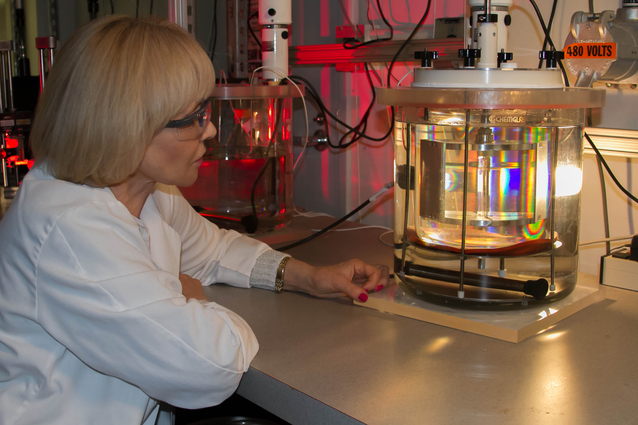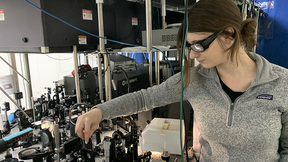LLNL wins three regional FLC awards
 (Download Image)
LLNL materials scientist Natalia Zaitseva checks out a stilbene crystal. The technology for growing these crystals has been licensed to Inrad Optics, a New Jersey photonics manufacturer. Zaitseva and her fellow scientists won one of three regional Federal Laboratory Consortium awards for technology transfer won by LLNL. Photo by Julie Russell/LLNL
(Download Image)
LLNL materials scientist Natalia Zaitseva checks out a stilbene crystal. The technology for growing these crystals has been licensed to Inrad Optics, a New Jersey photonics manufacturer. Zaitseva and her fellow scientists won one of three regional Federal Laboratory Consortium awards for technology transfer won by LLNL. Photo by Julie Russell/LLNL
Lawrence Livermore National Laboratory scientists have been selected to receive three regional awards for technology transfer by the Federal Laboratory Consortium.
This year's awards will be presented Aug. 26 during the FLC's two-day Far West/Mid-Continent regional meeting at the Sheraton Denver Downtown Hotel in Denver, Colorado.
Started in 1974, the consortium assists the U.S. public and private sectors in utilizing technologies developed by federal government research laboratories.
LLNL shared in awards for the development of a detector to identify explosives, drugs and other substances; for the development of a material with superior properties to detect fast neutrons; and for the creation of a novel system that enables climate researchers to solve complex data analysis and visualization challenges.
Detecting explosives and drugs
A team of LLNL chemists from the Lab's Energetic Materials Center and the Forensic Science Center developed a miniaturized, portable, thin-layer chromatography (TLC) kit called the microTLC that can detect and identify unknown materials.
Originally developed to identify military explosives, the microTLC has been modified and now can also detect illicit drugs, selected environmentally-sensitive materials and precursors, along with determining the purity of the identified compounds.
The detection system was licensed to a small business, Field Forensics Inc., which is located in St. Petersburg, Florida. Field Forensics also licensed an earlier LLNL technology, the Easy Livermore Inspection Test for Explosives (ELITE), which has sold more than 100,000 units.
Three Laboratory employees - research scientists John Reynolds and Joe Satcher and Catherine Elizondo, a business development executive within the Lab's Industrial Partnerships Office (IPO) - did the work associated with the technology transfer efforts. The microTLC project was honored by the FLC as an "outstanding commercialization success."
The device fills in major capability gaps in field testing for explosives and narcotics. Its detection platform measures 1.5 by 2 inches and requires about three minutes for identification. The chemicals for the instrument are self-contained and it only requires battery power.
The principal applications of the microTLC are for the military monitoring of bulk and residual explosives and for law enforcement to monitor illicit substances such as explosives and drugs. It also could find use in field and laboratory applications for forensics and first responders.
Crystal used to detect nuclear materials
Working under a Department of Homeland Security grant, a team of LLNL scientists developed technology to produce large-scale, four-inch, high-optical quality stilbene crystals. Their work, in teaming with an East Coast photonics manufacturer, was recognized as an "outstanding commercialization success."
The LLNL solution-grown technology is important because it demonstrates a more scalable and more economical approach for producing stilbene crystals, which have superior properties for detecting fast neutrons. Detecting neutrons is a critical capability for identifying special nuclear materials like plutonium in homeland security applications, as well as for uses in research and radiation protection.
Stilbene crystals have long been recognized as offering excellent properties for detecting fast neutrons, but the material's limited commercial availability hindered its widespread adoption.
Melt-growth techniques used in industry yielded only limited large crystals, making them unsuitable for widespread use. Consequently, liquid scintillators have remained the dominant choice for fast neutron detection even though they have inferior properties.
The stilbene crystal growth technology has been licensed to Inrad Optics, a New Jersey photonics manufacturer and small business. The company also concluded a work-for-others agreement with LLNL to assemble solution-growth equipment.
"Until now, few options existed for detecting fast neutrons," said Inrad Optics' Chief Executive Officer Amy Eskilson. "Liquid and plastic scintillators have traditionally been used for fast neutron detection, but safety and performance limitations created an unmet need for better materials. We believe stilbene is an excellent alternative."
In June, Inrad Optics won two awards for its development of nuclear detection material licensed from LLNL. It was recognized by the Domestic Nuclear Detection Office for exceptional contributions to advanced materials development for neutron detection of nuclear materials. And the firm was named one of 25 companies to receive the Tibbetts Award from the U.S. Small Business Association for playing a critical role in research and development for the government.
Five LLNL employees -- Elizondo and research scientists Natalia Zaitseva, Steve Payne, Nerine Cherepy and Leslie Carman -- worked on the technology transfer efforts with Inrad Optics.
New tool to assist climate researchers
A partnership across government, academic and private sectors has created a novel system that enables climate researchers to solve their most complex data analysis and visualization challenges. The team's work was recognized by the FLC as "outstanding partnership."
With the Ultrascale Visualization Climate Data Analysis Tools (UV-CDAT), the software development team has achieved something that has never before been attempted, much less completed, at this level of software engineering for the climate community: the integration of more than 70 disparate scientific software packages and libraries for large-scale data analysis and visualization.
The partnership that brought UV-CDAT to life consists of LLNL; Lawrence Berkeley, Los Alamos and Oak Ridge national laboratories; the National Aeronautics and Space Administration's Goddard Space Flight Center, the National Oceanic and Atmospheric Administrations' Earth System Research Laboratory, New York University, the University of Utah, Kitware Inc. and Tech-X Corp.
The UV-CDAT tool is the first system to be successfully designed to run unrelated analysis and visualization tools and techniques while capturing independent workflows for enhancing reproducibility.
UV-CDAT's development was fueled by exponential increases in the computational and storage capabilities of high-performance computing platforms and the evolution of climate simulations toward high numerical fidelity, complexity and volume. These technological advances are coming at a time of explosive growth in climate data, with estimate of tens to hundreds of exabytes of data by 2025.
Much of the work to establish the UV-CDAT partnership was handled by project principal investigator Dean Williams, the head of Computation's Analytics and Informatics Management Systems team. Leah Rogers, a former business development executive in IPO, assisted with portions of the partnership.
This is the second year in a row that Williams and his team have garnered an FLC award. Last year, the team won an "outstanding partnership" award for its "Earth System Grid Federation."
Contact
 Stephen Wampler
Stephen Wampler
[email protected]
(925) 423-3107
Related Links
Federal Laboratory ConsortiumTags
ScienceFeatured Articles







